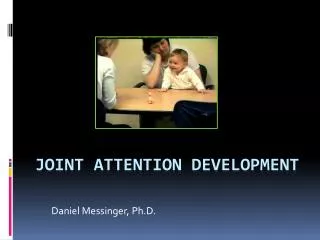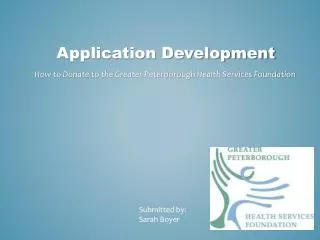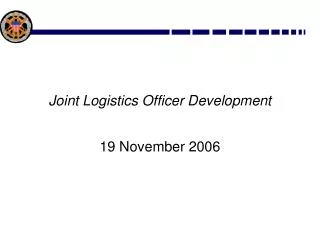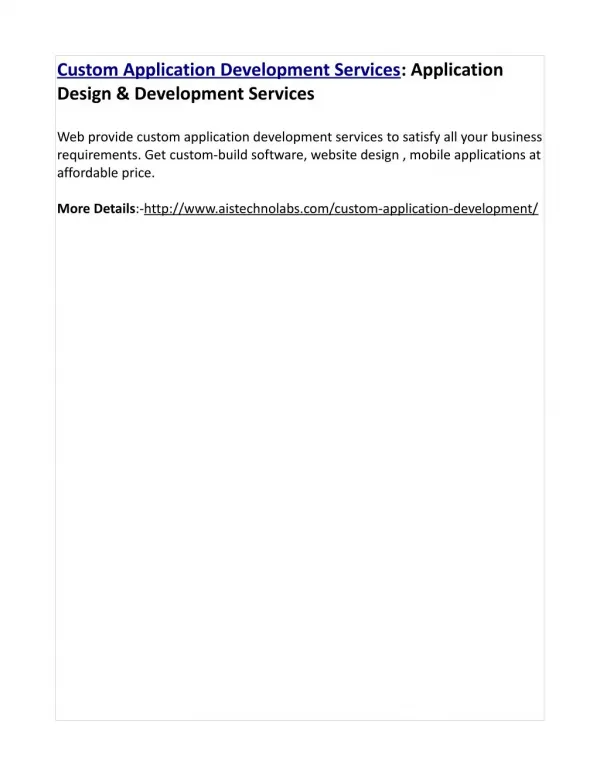Joint Application Development
Joint Application Development. Katie Abbott Ryan Abbott. Agenda: Joint Application Development. Introduction Systems Development Lifecycle Origin Evolution Other Names Basic Components of a JAD Session Guidelines for a Successful JAD Automated JAD Examples Summary. Introduction.
Share Presentation
Embed Code
Link
Download Presentation
- jad
- automated jad
- jad sessions
- successful jad
- joint application design
- automated jad ajad sessions

daryle + Follow
Download Presentation
Joint Application Development
An Image/Link below is provided (as is) to download presentation Download Policy: Content on the Website is provided to you AS IS for your information and personal use and may not be sold / licensed / shared on other websites without getting consent from its author. Content is provided to you AS IS for your information and personal use only. Download presentation by click this link. While downloading, if for some reason you are not able to download a presentation, the publisher may have deleted the file from their server. During download, if you can't get a presentation, the file might be deleted by the publisher.
Presentation Transcript
- Joint Application Development Katie Abbott Ryan Abbott
- Agenda: Joint Application Development • Introduction • Systems Development Lifecycle • Origin • Evolution • Other Names • Basic Components of a JAD Session • Guidelines for a Successful JAD • Automated JAD • Examples • Summary
- Introduction • What is Joint Application Development? • Joint Application Development, or JAD, is a process originally developed for designing a computer-based system. It brings together business area people (end users) and IT (Information Technology) professionals in a highly focused workshop. The advantages of JAD include a dramatic shortening of the time it takes to complete a project. It also improves the quality of the final product by focusing on the up-front portion of the development lifecycle, thus reducing the likelihood of errors that are expensive to correct later on.
- Introduction (Cont.) • JAD centers around a structured workshop session. • Participants get together in a room to discuss the problem/project. • Everyone hears what the rest of the group has to say. • JAD can eliminate many of the problems with traditional meetings. • Meetings are not well regarded as a productive forum. • JAD turns meetings into workshops. • They are less frequent • More structured, and productive • An agenda provides the structure • The facilitator directs the process • Visual aids clarify concepts being discussed and the group dynamics, with constant feedback, stimulates creativity
- Introduction (Cont.) • JAD Purpose: to define the project, design a solution, and monitor the project until it reaches completion. • JAD Philosophy: The JAD process is based on four simple ideas: • People who actually do a job have the best understanding of that job. • People who are trained in information technology have the best understanding of the possibilities of that technology. • Information systems and business processes rarely exist in isolation -- they transcend the confines of any single system or office and effect work in related departments. People working in these related areas have valuable insight on the role of a system within a larger community. • The best information systems are designed when all of these groups work together on a project as equal partners.
- Introduction (Cont.) • JAD Scope • The JAD should cover the complete development life cycle of a system. • The JAD is usually a 3 to 6 month well-defined project. • For large-scale projects, it is recommended that the project be approached incrementally, and that separate JAD's be used for each increment.
- Systems Development Lifecycle • Conception • Requirements • Design • Implementation • Integration • Test • Maintenance
- Origins • JAD was developed by Chuck Morris and Tony Crawford of IBM • Crawford led several workshops to prove the concept • JAD became widely accepted in many companies, including the data processing industry • JAD definition according to Crawford: an interactive systems design concept involving discussion groups in a workshop setting
- Evolution • As JAD attained popularity in the 80's, people started to use the term to describe different things. • Workshop Techniques • Brainstorming Sessions • Motivational Meetings • As the popularity of JAD grew, its usage expanded to functions other than the requirement gathering in the system development life cycle(SDLC). It is now used in all phases of SDLC and is defined as a system development method.
- Evolution (Cont.) • Who uses JAD? • JAD was originally designed to address information system development. • A JAD session usually involves some aspects of system design, or development. • In recent years, JAD has become a joint venture among people who need to make decisions affecting multiple areas of an organization – it is used even in non-IT related projects. • In this case, JAD is defined as a structured workshop where people come together to plan projects, design systems, or make business decisions (whether IT related or not).
- Evolution (Cont.) • Who uses JAD? • Today, JAD is commonly used in several areas • Strategic Business Planning, • Strategic IS Plans • IS Architecture Definition • Re-engineering Business Processes • Detailed System Design • Process and Data Modeling • Project Management.
- Evolution (Cont.) • In the earlier days, the definition of JAD required users and developers to be together in the same physical location • Due to new improved technology Physical location is no longer a limit • Virtual meetings • Remote sites with packaged software
- Other Names • As the use of JAD expands from the requirement gathering to other phases of system development life cycle, many people now refer to JAD as Joint Application Development. Some of them stick to the original definition of Joint Application Design and still primarily use it as system requirement gathering technique
- Other Names (Cont.) • JAD sessions, whether for Joint Application Design or Joint Application Development, have many other names, including: • Accelerated Design • Facilitated Meetings • Facilitated Sessions • Facilitated Team Techniques • Facilitated Work Sessions • Group Design • Interactive Design • Interactive JAD • Joint Sessions • User Centered Design
- Basic Components of a JAD Session • JAD sessions: • Are more focused. • Are conducted in a dedicated environment. • Quickly drive major requirements. • Help better develop the "look & feel“ of the interface. • JAD participants typically include: • Project sponsor • Project lead • Facilitator • Scribe • End users • Developers • Observers • Subject matter experts
- All participants come together in a joint forum. Observers Project Sponsor Facilitator Scribe Subject Matter Experts Project Lead Developers End User
- Guidelines for a Successful JAD • A clear purpose shared by all team members - the project charter • A diverse team, representative of all areas effected by this project. • Every person in the group has equal responsibility and decision making power. • Every idea is valuable. Throughout the JAD, listen and acknowledge each idea and concern. Evaluating ideas during a brainstorming session will shut down the creative process. The best idea may never get said out of fear of being shot down. • Participation by everyone is very important. Encourage quieter members to speak, they often have the best ideas. Don't allow 1 or 2 members to dominate. This is the facilitators responsibility as well as the whole teams' responsibility.
- Guidelines for a Successful JAD (Cont.) • Listen when others speak, don't interrupt or talk while others are talking (side conversations may have great ideas. we don't want to miss them). • Maintain a parking lot to record important issues that are not within the scope of this project. • Don't hold meetings, just to hold meetings. Only meet when there is something substantial to talk about. • Don't let more than 3 or 4 weeks pass between meetings, you will loose momentum. Remember, each meeting is a motivation for the team to complete tasks assigned. It is no fun to come to a meeting and admit you didn't finish your task. • Decisions are reached by consensus. We are here to create a win/win solution. win/lose solutions aren't good enough.
- Guidelines for a Successful JAD (Cont.) • Questions to ask • Are your meetings well attended? • Are all affected parties involved/aware of decisions being made? • Did you solve the true underlying problem? • Is your solution accepted and used by your clients? • Is the solution available on time?
- Guidelines for a Successful JAD (Cont.) • Pitfalls: • Sponsor not really committed - no resources • Unclear goals or objectives - lack of direction • Too many or too few members • Not enough communication with outsiders affected by decisions • Timelines aren't kept • Project Creep - project grows beyond the original definition and scope • Meetings aren't well facilitated • feels like nothing is accomplished in the meeting - old items not within scope keep getting revisited over and over • 1 or 2 members dominate discussions
- Automated JAD • JAD can be coupled with use of computer aided software engineering(CASE) tools • Some of the JAD tasks can be automated and various software tools are available today to assist with Automated JAD (AJAD) sessions. • Traditionally, word processors are used by the scribe to record the essence of JAD sessions. Sometimes, CASE tools are used to capture models in real time. • However, due to its complexity, the use of CASE tools usually slows down the process and becomes the bottleneck.
- Automated JAD (Cont.) • JAD sessions can also benefit from the use of Group Support Systems (GSS) or Electronic Meeting System (EMS) • Parallel communication • Group Memory • Anonymity encourages participation • However, communication through GSS is less "rich" than face-to-face verbal interaction and it is more difficult to resolve differences among participants with GSS. So the combination of JAD with GSS and traditional JAD might be the best solution.
- Automated JAD (Cont.) • The Internet and the Web have created many new opportunities for group work. It is now possible to include participants from many remote locations, so that, in theory, the size of the user group can become quite large, including participants from anywhere in the world.
- Examples
- Summary • BENEFITS OF JAD • Enhanced communication and relationship between business end users and IT personnel • Build consensus and ownership • Reduced system cost and development time • Reduced function creep • Improved system quality and productivity • Design cross-functional solutions • Helps project teams get focused and stay focused • Helps you get the right job done at the right time!
- References/ Where to Get More Information Data Warehouse Training: Development Methodology - Joint Application Development (JAD) http://www.datawarehouse-training.com/Methodologies/joint-application-design.htm Human Resource Services: Joint Application Development (JAD) What do you really want? http://www.utexas.edu/hr/is/pubs/jad.html#why Bauhaus Consulting Group: Fundamentals of Joint Application Development (JAD) http://www.bcgrp.com/JAD4.htm Netmation: Joint Application Development (JAD)http://www.netmation.com/docs/bb12.htm JAD Sessions http://www.thehathaway.com/Workshops.html Joint Application Design/Development: Mei C. Yatco http://www.umsl.edu/~sauter/analysis/JAD.html

Android application development
Android applications are fun to develop. Our Android developers have excellent experience in Android Application Development.
937 views • 18 slides

Joint AAR Architecture Development
Joint AAR Architecture Development. Evolution of the OneSAF AAR Architecture. Evolving the Architecture. Baseline Architecture Receive Stakeholder Requirements Allocate Stakeholder Requirements Develop Use Case Scenarios Identify Extensions Define Extensions.
544 views • 24 slides

Force Application Joint Functional Concept
UNCLASSIFIED. Force Application Joint Functional Concept . Bill Aldridge Force Application Maneuver Division, J8 9 January 2007. UNCLASSIFIED. Overview of Concept.
350 views • 5 slides

Joint Concept Development Experimentation Future Joint Operations
413 views • 10 slides

android application development | iPad application development | iPhone application development
android application development | iPad application development | iPhone application development
217 views • 2 slides

Solana Beach Joint Development
RELATED TO AGENDA ITEM 4. Solana Beach Joint Development. Performance, Administration and Finance Committee April 3, 2014. Project Objectives. Create an economic benefit to the area Generate long-term revenue stream to support NCTD’s transit operations
141 views • 0 slides

Joint Attention Development
Daniel Messinger, Ph.D. Joint Attention Development. Developmental overview. From 9 to 15 months, general increase in the % of infants: who gesture conventionally e.g. offering and pointing, though requesting is unclear and who comprehend conventional gestures
1.16k views • 60 slides

Application Development
Application Development. How to Donate to the Greater Peterborough Health Services Foundation. Submitted by: Sarah Boyer. I chose to use Screen-Cast-o- Matic to demonstrate to users how to donate to the Greater Peterborough Health Services Foundation
141 views • 5 slides

Joint Product Development Workshop
Joint Product Development Workshop. Tuesday 5 th February Tower Hotel. Business Opportunities Programme . Business Opportunities Programme.
223 views • 10 slides

Project Front-End Loading with Facilitated Joint Application Development (JAD) Techniques
Professional Development Day PMI Honolulu - May 3, 2006. Project Front-End Loading with Facilitated Joint Application Development (JAD) Techniques. Walter A. Viali, CSQA, PMP PMO To Go LLC. Walter A. Viali. Over 32 years in Information Technology
865 views • 66 slides

Joint Logistics Officer Development
Joint Logistics Officer Development. 19 November 2006. Functional Solutions Analysis. Functional Solutions Analysis. Functional Solutions Analysis. Functional Solutions Analysis. Joint Logistics Education…Concepts to Capabilities. Develop Vision of Joint Logistician’s role in Future.
288 views • 9 slides

The Joint Application Package
The Joint Application Package. Joint Application Package. A tool designed to facilitate integrated planning, implementation, M&E and reporting of preventive chemotherapy interventions. It includes: Joint Request for Selected PC Medicines (ALB, MEB, PZQ, DEC, IVM)
267 views • 6 slides

APPLICATION DEVELOPMENT
APPLICATION DEVELOPMENT. BY SYED ADNAN ALI. What is an Application Development?. An application is defined as a program that gives a computer instructions, that provide the user with tools to accomplish a task. Development of such an application is known as Application Development.
543 views • 31 slides

Joint Application Design Team
Joint Application Design Team. Federal Demonstration Partnership. Support for Pilots. Paperwork Reduction Act 1980 - 1995
282 views • 8 slides

Introduction to Information Systems Analysis Systems Analysis Joint Application Development
Introduction to Information Systems Analysis Systems Analysis Joint Application Development. INFO 503 Glenn Booker. What is System Analysis?. System Analysis (logical design) is the dissection of a system into pieces (subsystems), and the study of how those pieces interact and work
680 views • 50 slides

Joint application of spring 2015
Joint application of spring 2015. 7–27 January 2015 www.studyinfo.fi. Bachelor’s degree programmes. HAMK offers four Bachelor's degree programmes conducted in English in 2015: Degree Programme in Construction Engineering Degree Programme in Electrical and Automation Engineering
361 views • 17 slides

Application Development
Anthem Infotech Provides Web Designing Services HTML 5 ASP.Net Development Custom Software Development Desktop Applications Windows Applications SEO and Android Application.
261 views • 10 slides

Joint divorce application form
DIY divorce online. Simple or joint divorce application. Uncontested divorce proceedings. Easy to answer questions. Fill out the online questions and divorce I.t will complete all your necessary divorce forms. Instantly prints your forms. Will only take 20 minutes of your time. Fast! http://divorceit.ca/
214 views • 5 slides

Custom Application Development Services: Application Design & Development Services
Web provide custom application development services to satisfy all your business requirements. Get custom-build software, website design , mobile applications at affordable price.





















